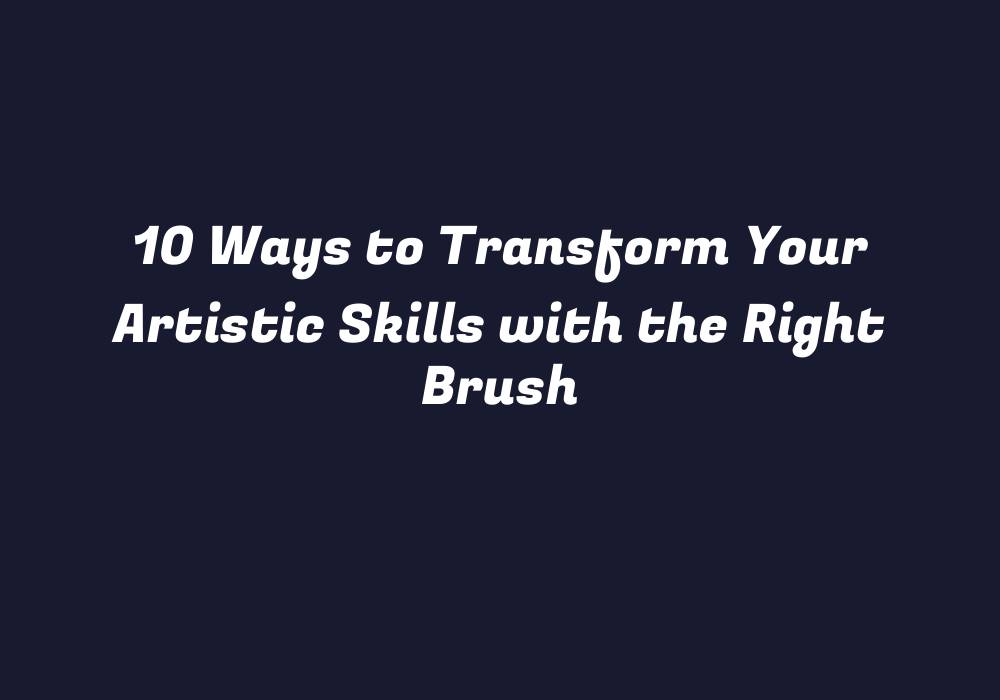Transforming Your Artistic Skills with the Right Brush
Introduction
Art is a unique way to express one’s emotions, thoughts, and creativity. It has been around for centuries and continues to evolve as people find new ways to make their artistic visions a reality. A crucial aspect of any artwork is the choice of brush. This guide will explore 10 ways in which selecting the right brush can transform your artistic skills.
1. Understanding Brush Types
The first step in using the right brush for your art is being familiar with the different types available. Here are some common options:
a) Flat brushes: These have a wide, even surface and hold a lot of paint or ink. They work well for blocking out large areas in an artwork.
b) Round brushes: With a tapered shape, round brushes are great for detailed work, contours, and fine lines. They are also perfect for creating smooth blends and gradients.
c) Filbert brushes: These brushes feature rounded edges that allow for both blending and detailing in your artwork.
d) Bright brushes: With a distinctive wedge-like shape, bright brushes are ideal for creating textures and patterns.
e) Rigger brushes: Designed to have sharp tips, rigger brushes offer precise control when working on delicate or intricate details.
2. Selecting Brush Size
The size of your brush matters greatly depending on the style you’re trying to achieve and the techniques you employ. For larger areas, go with bigger brushes that can hold more paint or ink. Smaller brushes are better suited for detailed work and intricate patterns. It’s also crucial to consider the scale of your artwork and adjust accordingly.
3. Brush Firmness
Brushes come in varying degrees of firmness, from extremely soft to quite stiff. Softer brushes are generally better for blending and creating smooth gradients, while stiffer ones work best for precise lines and controlled brush strokes. Experiment with different brush types to find the perfect balance between control and versatility for your desired artistic style.
4. Brush Material
Brush materials also play a significant role in determining the look and feel of your artwork. Natural brushes are usually made from animal hair, such as squirrel or sable. These brushes often have softer, more delicate tips that make them ideal for blending and creating fine details. On the other hand, synthetic brushes are generally made from nylon or polyester fibers, offering a more affordable alternative with good paint-holding abilities.
5. Brush Care
Properly maintaining your brushes will ensure they perform at their best and last for years. Clean your brushes after each painting session to prevent paint buildup and keep them in great condition. Store brushes flat on a clean cloth or in a designated brush holder, ensuring the tips of the brushes are not touching each other or any hard surfaces. This will protect them from damage.
6. Mixing Brush Techniques
Combining different brush techniques can create a diverse range of textures and effects in your artwork. Some common techniques include:
a) Wet-on-wet: This method involves painting with wet paint directly on the canvas, allowing the colors to merge and blend naturally.
b) Dry-brush technique: Apply very little or no paint to a brush, then drag it across the surface of your artwork to create highlights or textures.
c) Splattering: Dip the tips of your brushes in paint, flick them against the canvas to create an abstract, messy texture.
d) Scumbling: Paint using horizontal strokes with your flat brush to create subtle color transitions and gradients.
e) Loading: Apply more paint on the tip of a round brush by twisting or dipping it back into the paint before making your mark.
7. Practice, Patience, and Persistence
To truly transform your artistic skills with the right brush, you must practice consistently and patiently. Keep working on developing new techniques and challenging yourself to explore different ways of using your chosen brushes. The more you put in the effort, the better you will become at mastering the various aspects of art that involve brushwork.
8. Experiment with Different Brush Strokes
Your brush strokes can significantly impact the overall feel and appearance of your artwork. To create depth and dimension in your pieces, experiment with different types of strokes such as dots, lines, swirls, or even abstract marks. Keep in mind that the unique character of each stroke can help bring life to your creations.
9. Embrace the Power of Color
Brushes also play a role in how you apply color to your artwork. Consider trying different brush styles and materials to achieve distinct color effects, such as creating smooth washes with natural hair brushes or using synthetic bristles for bold strokes. Explore color theory and experiment with contrasting hues to enhance the emotional impact of your art.
10. Find Inspiration in Your Surroundings
Surround yourself with artistic inspiration to fuel your creative journey. Look beyond traditional artwork for ideas and explore diverse mediums, such as photography, sculpture, or even nature itself. Be open-minded about incorporating new influences into your work, as this can lead to exciting breakthroughs in your brush technique and overall artistry.
Conclusion
Transforming your artistic skills with the right brush involves understanding brush types, sizes, materials, and techniques, while also embracing creativity and patience throughout your journey. By experimenting with different brush styles and strokes, you can create unique artworks that truly reflect your vision and passion for self-expression.
